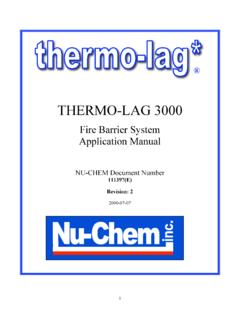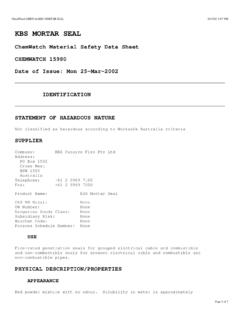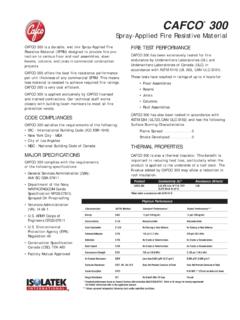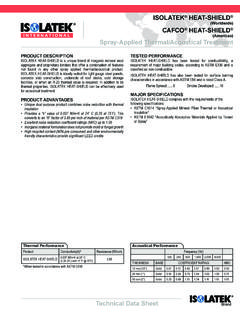Transcription of Hydrocarbon - Front Cover
1 Is passive fire protection?Before deciding which fire protection system to use, it isimportant to distinguish between activeand passivefireprotection active fire protection system reacts to conditions causedby a fire such as heat, smoke or light and tries to extinguishthe blaze. This can be done either by drenching via asprinkler system, by creating a warning via a smoke alarm,or by activating a fire defence system such as a fire fire protection is undoubtedly very effective, but hasthe in-built disadvantage of being dependent upon each ofthe various elements of the chosen system working.
2 Anyvandalism of the water feed mechanism, damage to theoperating valves, or simply ignorance, can render the systeminoperative. It would be unwise, therefore, to construct abuilding s fire defence around a single system that cannotalways be passive fire protection system on the other hand, insulatesa structure and prevents it from collapsing when subjectedto the effects of fire. Such protection buys time for theoccupants to escape, and/or for the fire fighting services tosafely enter, and remain in or near, the structure in order tocontain and extinguish the conflagration.
3 Many passive fireprotection materials also give added benefits such as thermaland acoustic insulation. Active and passive systems are complementary, notcompetitive. Legislation recognises this by allowing them towork in tandem. For example, if sprinklers are employed, areduced degree of passive protection is of fireLike fire protection systems, fires are also considered in two are classified as either cellulosicor Hydrocarbon . In fireprotection terms, the difference between the two types of fire is thetimeit takes for the fire to reach its maximum temperature test conditions a Hydrocarbon fire will reach a temperature of900 C in 8 minutes, whilst a cellulosic fire will take 60 minutes to reachthe same level.
4 See figure ( C)time (mins)1400120010008006004002000010203040 5060708090100110120 Hydrocarbon (RWS standard)HydrocarbonCellulosic BS 476 Cellulosic ISO 834 Cellulosic fires are those that aresustained by cellulosic products(eg., timber, fabrics, paper, etc)encountered in such buildings asoffices, hospitals, shopping malls,schools, etc. Hydrocarbon fires occur inpetrochemical installations or oiland gas production facilities whenhydrocarbon chemicals and fuelsignite. Within a few minutes ofignition, the temperature of thefire can reach 1100 C, andunprotected loaded steelstructures may collapse due toloss of strength as theirtemperature vessels will also absorbheat and weaken as the shelltemperature and internal pressureincrease.
5 When the internalpressure exceeds the mechanicalstrength of the vessel,catastrophic failure may occur inthe form of a BLEVE (BoilingLiquid Expanding VapourExplosion).As a consequence, fragments ofthe vessel may be propelled overconsiderable distances. Inaddition, the fire ball with itsintense thermal radiation cancause destruction over a widearea. It should be noted thatrapid vessel failure can occur evenif a correctly sized pressure reliefvalve has been fitted. A third possible sub-section of thehydrocarbon fire is a fire in atunnel. Here, the basic concept isa burning fuel tanker and as suchthe fire is fundamentallyhydrocarbon in nature, but thetesting temperature is to 1300 C(RWS) rather than the 1120 C ofthe standard Hydrocarbon orcellulosic fire.
6 For a detaileddiscussion of the specialrequirements of passive fireprotection in tunnels, refer toCafco International s 1: Comparison of typical cellulosic and Hydrocarbon time/temperature curves4 The need to insulate againsthydrocarbon firesPassive fire protection is designed to insulatesteel or concrete technique ensures that the substrate temperature does not reach thelevel that causes the steel to buckle and collapse, or the concrete to types of passive fire protectionproduct for Hydrocarbon firesThere are two generic types of passive fire protection coatingswhere each product has its own unique way of achieving the both types.
7 A mesh retention system is always used for long termservice durability in exterior environments or where vibration of astructure may be Cementitious coatingsCementitious coatings are sub-divided into wet (cement orgypsum based) or dry (mineralwool based) systems. Wet mix indicates that theproduct is pre-mixed with wateron site to form a slurry, and thenconveyed under pressure througha hose to a spray nozzle wherecompressed air is introduced priorto application. Dry mix indicatesthat there is no need to pre-mix Steel loses its structural integritybetween 550 C and 620 C whenfully loaded.
8 Standard testingmethods are based uponexposing protected steel sectionsto furnace temperatures thatreach 837 C in 30 minutes,940 C in 60 minutes, 1001 C in90 minutes and 1044 C in a fully loaded structural elementis exposed to these temperatures,failure is deemed to occur whenthe steel has deflected to itsmaximum before collapse, orwhen all, or part of the coatingfalls off. Obviously, if the coatingcomes away, the protected steelsection is exposed to the furnacetemperature and rapidly reachesthe failure range of 550 to620 C. For this reason, thewith water. Instead, the materialis conveyed in its original state byair under low pressure.
9 Atomizedwater is introduced at the spraynozzle just prior to application. Both wet and dry spray coatingsachieve the required insulationwhen they set after application,and require no activation by heator appropriate, thesecoatings may also be trowelapplied to achieve the beam or column tests arealso known as the stickability addition to its ability to preventthe structural steel from reachingthe temperature at which it willcollapse, a passive fire protectionproduct itself must not signifi-cantly contribute to the quantityof combustible material in fire protection productsare therefore tested for the extentof their inherent fire resistingproperties, that includes:a)combustibilityb)rate of surface spread of flamec)contribution to Intumescent coatingsIntumescent coatings are usuallyepoxy based and may be appliedby spray or trowel.
10 Intumescentcoatings react to elevated temper-atures by swelling to many timestheir applied thickness. It is this enhanced thickness (orchar) that provides the a suitable passive fireprotection system for Hydrocarbon firesIn conjunction with using the Product Selector,for an application suchas a steel structure for example, the specifier will also need to ask arange of questions when selecting the most suitable type of passive fireprotection system to resist Hydrocarbon is the substrate andlocation of the structure? the protection be visibleand maybe require anaesthetic finish?











